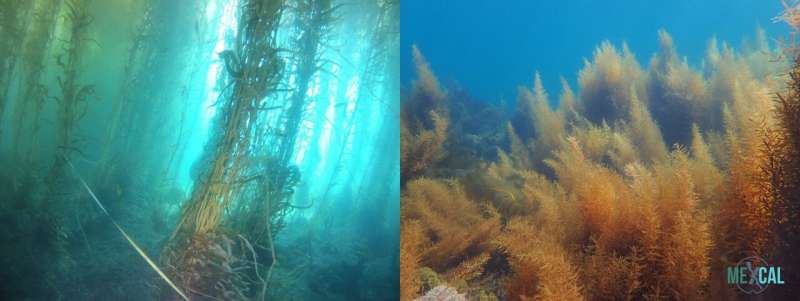'Warm Blob' marine heatwave helps invasive algae take over Baja Californian waters

An unusually long period of warm waters caused invasive species of algae to completely replace a community of native kelp surrounding a Mexican island, according to results published in Botanica Marina.
The waters of the Todos Santos Islands, around 120km off the northwest coast of Baja California in Mexico, are usually dominated by the giant kelp species Macrocystis pyrifera.
But an unusually long period of warm waters affecting the Pacific coast of North America from 2013 to 2016 (known as the "Warm Blob") seems to have shifted the location and population of several marine species.
"Those of us who have dove there before noticed the dramatic community change," said Dr. Luis Malpica-Cruz, one of the authors of the paper. Between 2018 and 2019, the authors assessed the density of the invasive species at a rocky reef roughly ten meters below the surface to see how the community had changed.
During that time they found that native kelps suffered greatly: M. pyrifera went from an average of 0.7 individuals per square meter in 2018 to zero in 2019. During that same time, the researchers say, there was a threefold increase of the population of the invasive macroalgae species Sargassum horneri and kelp species Undaria pinnatifida.
"We were shocked," said Malpica-Cruz. "We looked at other local sites that witnessed M. pyrifera loss and saw other native species had taken its place. But the Todos Santos site had a completely different kelp ecosystem."
The authors reason that the "Warm Blob" marine heatwave both held back the native M. pyrifera and allowed invasive species such as S. horneri and U. pinnatifida to thrive.
This alteration in the ecosystem could be the first sign of wider changes, with the dramatic loss of M. pyrifera affecting other algae, invertebrates and fish further up the food chain.
While the kelp slowly regained its territory from 2017 onwards at other locations, it continued to lose ground to invasive species at the Todos Santos Islands.
Malpica-Cruz says he doubts that native species will return to the islands' waters in the near future, since the dramatic shift happened within a year. "There is hope that not all M. pyrifera kelp forest will be lost. However in those forests that do change it is uncertain how the community will ultimately be impacted."
The authors want to continue studying the invasive species at these islands as it could help others to design strategies to manage invasive kelp when a future marine heatwave arrives.
More information: Ana Carolina Félix-Loaiza et al, Marine heatwaves facilitate invasive algae takeover as foundational kelp, Botanica Marina (2022). DOI: 10.1515/bot-2022-0037
Provided by De Gruyter
















